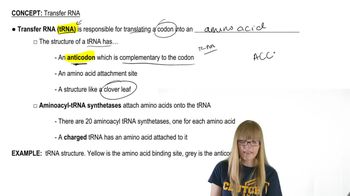Table of contents
- 1. Introduction to Genetics51m
- 2. Mendel's Laws of Inheritance3h 37m
- 3. Extensions to Mendelian Inheritance2h 41m
- 4. Genetic Mapping and Linkage2h 28m
- 5. Genetics of Bacteria and Viruses1h 21m
- 6. Chromosomal Variation1h 48m
- 7. DNA and Chromosome Structure56m
- 8. DNA Replication1h 10m
- 9. Mitosis and Meiosis1h 34m
- 10. Transcription1h 0m
- 11. Translation58m
- 12. Gene Regulation in Prokaryotes1h 19m
- 13. Gene Regulation in Eukaryotes44m
- 14. Genetic Control of Development44m
- 15. Genomes and Genomics1h 50m
- 16. Transposable Elements47m
- 17. Mutation, Repair, and Recombination1h 6m
- 18. Molecular Genetic Tools19m
- 19. Cancer Genetics29m
- 20. Quantitative Genetics1h 26m
- 21. Population Genetics50m
- 22. Evolutionary Genetics29m
7. DNA and Chromosome Structure
RNA
Problem 19
Textbook Question
What are the three major types of RNA molecules? How is each related to the concept of information flow?
 Verified step by step guidance
Verified step by step guidance1
Identify the three major types of RNA molecules: messenger RNA (mRNA), ribosomal RNA (rRNA), and transfer RNA (tRNA).
Explain the role of mRNA: It carries the genetic information from DNA to the ribosome, where proteins are synthesized. This is a key part of the central dogma of molecular biology, which describes the flow of genetic information from DNA to RNA to protein.
Describe the function of rRNA: It is a component of ribosomes, which are the molecular machines that facilitate the translation of mRNA into proteins. rRNA helps to ensure the proper alignment of mRNA and tRNA and catalyzes the formation of peptide bonds between amino acids.
Discuss the role of tRNA: It transports the appropriate amino acids to the ribosome during protein synthesis. Each tRNA molecule has an anticodon that pairs with a complementary codon on the mRNA, ensuring that the correct amino acid is added to the growing polypeptide chain.
Connect these roles to the concept of information flow: mRNA, rRNA, and tRNA work together to translate the genetic code into functional proteins, illustrating the flow of information from DNA to RNA to protein, which is fundamental to cellular function and gene expression.
Recommended similar problem, with video answer:
 Verified Solution
Verified SolutionThis video solution was recommended by our tutors as helpful for the problem above
Video duration:
53sPlay a video:
Was this helpful?
Key Concepts
Here are the essential concepts you must grasp in order to answer the question correctly.
Messenger RNA (mRNA)
Messenger RNA (mRNA) is a type of RNA that carries genetic information from DNA to the ribosome, where proteins are synthesized. It serves as a template for translation, allowing the sequence of nucleotides in the mRNA to dictate the order of amino acids in a protein. This process is crucial for the expression of genes and the flow of information from the genetic code to functional proteins.
Recommended video:
Transfer RNA (tRNA)
Transfer RNA (tRNA) is responsible for bringing the appropriate amino acids to the ribosome during protein synthesis. Each tRNA molecule has an anticodon that pairs with a corresponding codon on the mRNA, ensuring that the correct amino acid is added to the growing polypeptide chain. This role is essential for translating the genetic information encoded in mRNA into functional proteins.
Recommended video:
Ribosomal RNA (rRNA)
Ribosomal RNA (rRNA) is a structural and functional component of ribosomes, the cellular machinery that synthesizes proteins. rRNA helps to catalyze the formation of peptide bonds between amino acids and ensures the proper alignment of mRNA and tRNA during translation. Its role is vital in the information flow process, as it facilitates the translation of genetic information into proteins.
Recommended video:
Related Videos
Related Practice





